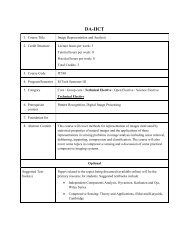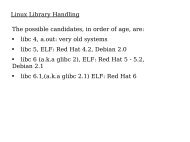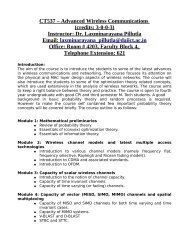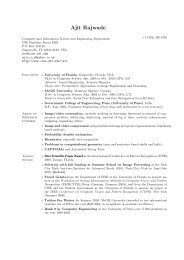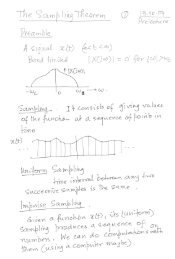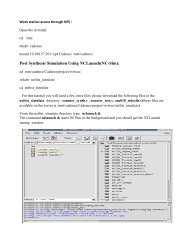Probability Density Estimation using Isocontours and Isosurfaces ...
Probability Density Estimation using Isocontours and Isosurfaces ...
Probability Density Estimation using Isocontours and Isosurfaces ...
Create successful ePaper yourself
Turn your PDF publications into a flip-book with our unique Google optimized e-Paper software.
Hence, we have<br />
p(α) = 1<br />
<br />
d<br />
A dα<br />
I(x,y)≤α<br />
dxdy. (3)<br />
We can now adopt a change of variables from the spatial<br />
coordinates (x,y) to u(x,y) <strong>and</strong> I(x,y), where u <strong>and</strong> I are the<br />
directions parallel <strong>and</strong> perpendicular to the level curve of intensity<br />
α, respectively. Observe that I points in the direction of the image<br />
gradient, or the direction of maximum intensity change. Noting<br />
this fact, we now obtain the following:<br />
p(α) = 1<br />
<br />
A<br />
I(x,y)=α<br />
<br />
<br />
<br />
<br />
<br />
∂x<br />
∂I<br />
∂x<br />
∂u<br />
∂y<br />
∂I<br />
∂y<br />
∂u<br />
<br />
<br />
<br />
du.<br />
(4)<br />
<br />
Note that in Eq. (4), dα <strong>and</strong> dI have “canceled” each other out,<br />
as they both st<strong>and</strong> for intensity change. Upon a series of algebraic<br />
manipulations, we are now left with the following expression<br />
for p(α) (with a more detailed derivation to be found in the<br />
Appendix):<br />
p(α) = 1<br />
<br />
A I(x,y)=α<br />
du<br />
<br />
( ∂I<br />
∂x )2 + ( ∂I<br />
∂y )2<br />
. (5)<br />
From the above expression, one can make some important<br />
observations. Each point on a given level curve contributes a<br />
certain measure to the density at that intensity which is inversely<br />
proportional to the magnitude of the gradient at that point.<br />
In other words, in regions of high intensity gradient, the area<br />
between two level curves at nearby intensity levels would be<br />
small, as compared to that in regions of lower image gradient<br />
(see Figure 1). When the gradient value at a point is zero (owing<br />
Level curve at α<br />
Level Curve at α+∆α<br />
Area between level curves<br />
Fig. 1. p(α) ∝ area between level curves at α <strong>and</strong> α + ∆α (i.e. region with red<br />
dots)<br />
to the existence of a peak, a valley, a saddle point or a flat region),<br />
the contribution to the density at that point tends to infinity. (The<br />
practical repercussions of this situation are discussed later on in<br />
the paper. Lastly, the density at an intensity level can be estimated<br />
by traversing the level curve(s) at that intensity <strong>and</strong> integrating the<br />
reciprocal of the gradient magnitude. One can obtain an estimate<br />
of the density at several intensity levels (at intensity spacing of h<br />
from each other) across the entire intensity range of the image.<br />
B. Estimating the Joint <strong>Density</strong><br />
Consider two images represented as continuous scalar valued<br />
functions w1 = I1(x,y) <strong>and</strong> w2 = I2(x,y), whose overlap area is<br />
A. As before, assume a location r<strong>and</strong>om variable Z = {X,Y }<br />
with a uniform distribution over the (overlap) field of view.<br />
Further, assume two new r<strong>and</strong>om variables W1 <strong>and</strong> W2 which<br />
are transformations of the r<strong>and</strong>om variable Z <strong>and</strong> with the<br />
transformations given by the gray-scale image intensity functions<br />
W1 = I1(X,Y ) <strong>and</strong> W2 = I2(X,Y ). Let the set of all regions whose<br />
intensity in I1 is less than or equal to α1 <strong>and</strong> whose intensity in<br />
I2 is less than or equal to α2 be denoted by L. The cumulative<br />
distribution Pr(W1 ≤ α1,W2 ≤ α2) at intensity values (α1,α2) is<br />
equal to the ratio of the total area of L to the total overlap area<br />
A. The probability density p(α1,α2) in this case is the second<br />
partial derivative of the cumulative distribution w.r.t. α1 <strong>and</strong> α2.<br />
Consider a pair of level curves from I1 having intensity values α1<br />
<strong>and</strong> α1 + ∆α1, <strong>and</strong> another pair from I2 having intensity α2 <strong>and</strong><br />
α2 + ∆α2. Let us denote the region enclosed between the level<br />
curves of I1 at α1 <strong>and</strong> α1 + ∆α1 as Q1 <strong>and</strong> the region enclosed<br />
between the level curves of I2 at α2 <strong>and</strong> α2 + ∆α2 as Q2. Then<br />
p(α1,α2) can geometrically be interpreted as the area of Q1 ∩Q2,<br />
divided by ∆α1∆α2, in the limit as ∆α1 <strong>and</strong> ∆α2 tend to zero. The<br />
regions Q1, Q2 <strong>and</strong> also Q1 ∩ Q2 (dark black region) are shown<br />
in Figure 2(left). Using a technique very similar to that shown<br />
in Eqs. (2)-(4), we obtain the expression for the joint cumulative<br />
distribution as follows:<br />
Pr(W1 ≤ α1,W2 ≤ α2) = 1<br />
A<br />
<br />
L<br />
3<br />
dxdy. (6)<br />
By doing a change of variables, we arrive at the following<br />
formula:<br />
Pr(W1 ≤ α1,W2 ≤ α2) = 1<br />
<br />
<br />
<br />
<br />
A L <br />
∂x<br />
∂u1<br />
∂x<br />
∂u2<br />
∂y<br />
∂u1<br />
∂y<br />
∂u2<br />
<br />
<br />
<br />
<br />
du1du2. (7)<br />
Here u1 <strong>and</strong> u2 represent directions along the corresponding level<br />
curves of the two images I1 <strong>and</strong> I2. Taking the second partial<br />
derivative with respect to α1 <strong>and</strong> α2, we get the expression for<br />
the joint density:<br />
p(α1,α2) = 1 ∂<br />
A<br />
2<br />
<br />
<br />
<br />
<br />
∂α1∂α2 L <br />
∂x<br />
∂u1<br />
∂x<br />
∂u2<br />
∂y<br />
∂u1<br />
∂y<br />
∂u2<br />
<br />
<br />
<br />
<br />
du1du2. (8)<br />
It is important to note here again, that the joint density in (8)<br />
may not exist because the cumulative may not be differentiable.<br />
Geometrically, this occurs if (a) both the images have locally<br />
constant intensity, (b) if only one image has locally constant<br />
intensity, or (c) if the level sets of the two images are locally<br />
parallel. In case (a), we have area-measures <strong>and</strong> in the other<br />
two cases, we have curve-measures. These cases are described<br />
in detail in the following section, but for the moment, we shall<br />
ignore these degeneracies.<br />
To obtain a complete expression for the PDF in terms of<br />
gradients, it would be highly intuitive to follow purely geometric<br />
reasoning. One can observe that the joint probability density<br />
p(α1,α2) is the sum total of “contributions” at every intersection<br />
between the level curves of I1 at α1 <strong>and</strong> those of I2 at<br />
α2. Each contribution is the area of parallelogram ABCD [see<br />
Figure 2(right)] at the level curve intersection, as the intensity<br />
differences ∆α1 <strong>and</strong> ∆α2 shrink to zero. (We consider a parallelogram<br />
here, because we are approximating the level curves<br />
locally as straight lines.) Let the coordinates of the point B be<br />
( ˜x, ˜y) <strong>and</strong> the magnitude of the gradient of I1 <strong>and</strong> I2 at this point be<br />
g1( ˜x, ˜y) <strong>and</strong> g2( ˜x, ˜y). Also, let θ( ˜x, ˜y) be the acute angle between<br />
the gradients of the two images at B. Observe that the intensity<br />
difference between the two level curves of I1 is ∆α1. Then, <strong>using</strong><br />
the definition of gradient, the perpendicular distance between the<br />
two level curves of I1 is given as ∆α1<br />
g1( ˜x, ˜y) . Looking at triangle CDE<br />
(wherein CE is perpendicular to the level curves) we can now





